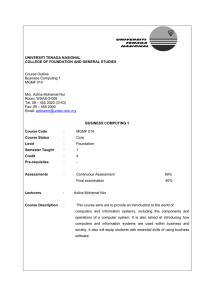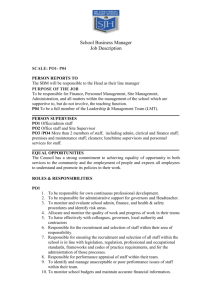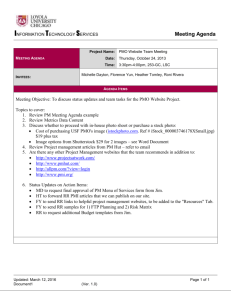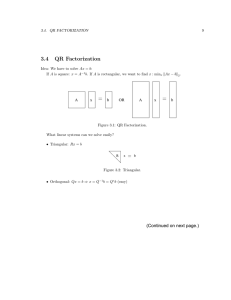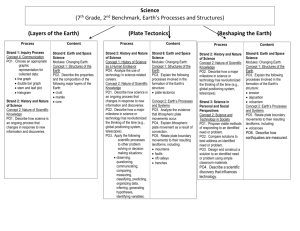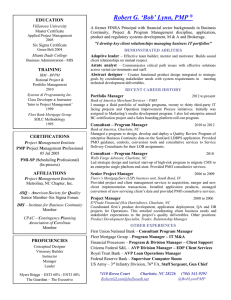To engage students in the engineering design process through the creation... in their area Grand Challenge: Restore and Improve Urban Infrastructure
advertisement
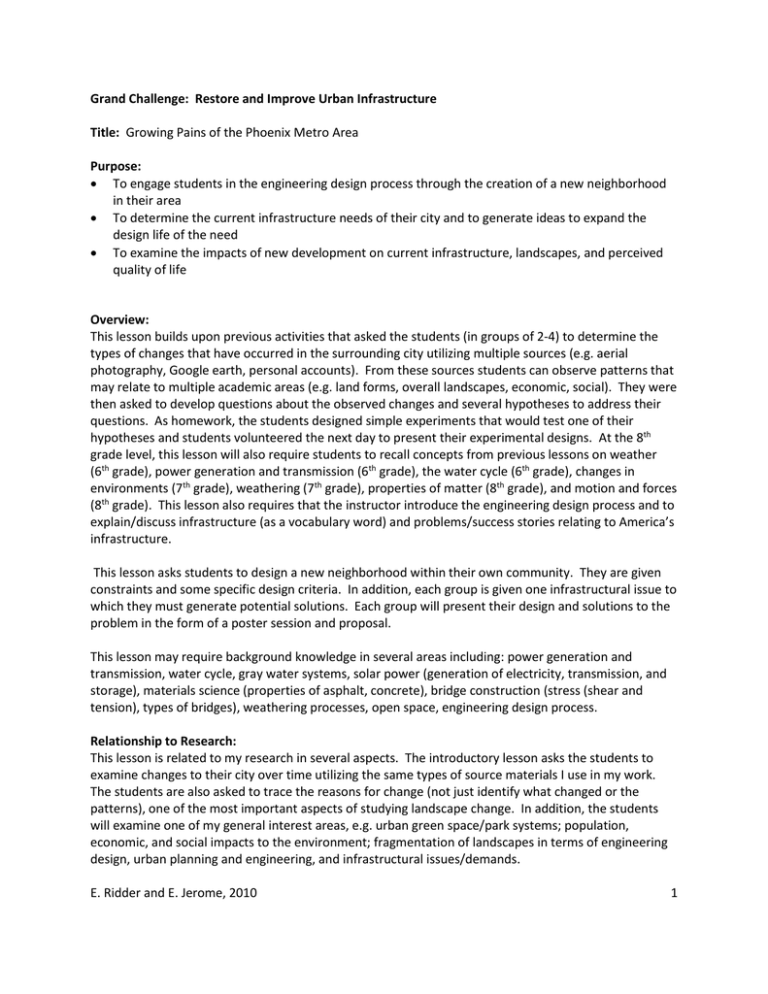
Grand Challenge: Restore and Improve Urban Infrastructure Title: Growing Pains of the Phoenix Metro Area Purpose: To engage students in the engineering design process through the creation of a new neighborhood in their area To determine the current infrastructure needs of their city and to generate ideas to expand the design life of the need To examine the impacts of new development on current infrastructure, landscapes, and perceived quality of life Overview: This lesson builds upon previous activities that asked the students (in groups of 2-4) to determine the types of changes that have occurred in the surrounding city utilizing multiple sources (e.g. aerial photography, Google earth, personal accounts). From these sources students can observe patterns that may relate to multiple academic areas (e.g. land forms, overall landscapes, economic, social). They were then asked to develop questions about the observed changes and several hypotheses to address their questions. As homework, the students designed simple experiments that would test one of their hypotheses and students volunteered the next day to present their experimental designs. At the 8th grade level, this lesson will also require students to recall concepts from previous lessons on weather (6th grade), power generation and transmission (6th grade), the water cycle (6th grade), changes in environments (7th grade), weathering (7th grade), properties of matter (8th grade), and motion and forces (8th grade). This lesson also requires that the instructor introduce the engineering design process and to explain/discuss infrastructure (as a vocabulary word) and problems/success stories relating to America’s infrastructure. This lesson asks students to design a new neighborhood within their own community. They are given constraints and some specific design criteria. In addition, each group is given one infrastructural issue to which they must generate potential solutions. Each group will present their design and solutions to the problem in the form of a poster session and proposal. This lesson may require background knowledge in several areas including: power generation and transmission, water cycle, gray water systems, solar power (generation of electricity, transmission, and storage), materials science (properties of asphalt, concrete), bridge construction (stress (shear and tension), types of bridges), weathering processes, open space, engineering design process. Relationship to Research: This lesson is related to my research in several aspects. The introductory lesson asks the students to examine changes to their city over time utilizing the same types of source materials I use in my work. The students are also asked to trace the reasons for change (not just identify what changed or the patterns), one of the most important aspects of studying landscape change. In addition, the students will examine one of my general interest areas, e.g. urban green space/park systems; population, economic, and social impacts to the environment; fragmentation of landscapes in terms of engineering design, urban planning and engineering, and infrastructural issues/demands. E. Ridder and E. Jerome, 2010 1 Relationship to Grand Challenge: This lesson asks students to suggest solutions to issues relating to urban infrastructure. The students are required to identify the need/issue, propose solutions, design a model, and to justify their model/design decisions through a presentation to their classmates. Grade Levels: 6 – 8 Materials: Internet access Graph paper Butcher paper – 1 sheet per group (4 students), size dependent upon classroom wall space with bounding streets and a scale bar drawn in for the students Markers/colored pencils Rulers Construction paper Scissors Glue sticks/tape Map of area to help with scaling and layout of surrounding communities Bell ringer video Introduction with examples of infrastructure, past and current issues, how issues are addressed, success stories, introduction to engineering design process Rubric for students to assess each other during group work, to assess other student’s posters Design specifications handout/homework Rubric for instructor evaluation of posters and design justifications by students Time required: Four 50-minute class sessions Learning Activity Day 1: Show bell ringer video while students are entering classroom and getting settled. This video has examples of infrastructure and includes examples of engineering failures and successes (~8-10 minutes). Begin introduction to different types of infrastructure through example first, then class generated ideas. Discuss different types of problems experienced with each type of infrastructure and how these problems are addressed. Also introduce engineering “success stories” in terms of improvements in materials, design, and technology (~15-20 minutes). Introduce engineering design process and walk students through the cycle (~10 minutes). Hand out assignment for Day 2 (design specifications handout). Assign homework (two parts): (1) students (as individuals) need to brainstorm ideas on how to address their group’s infrastructural problem; (2) students will identify an infrastructure issue within their community, city, or state and create potential solutions to increase the infrastructure’s lifespan by 25 years (not allowed to suggest E. Ridder and E. Jerome, 2010 2 complete re-build). Students will hand in or instructor will spot check (participation/completion points) homework assignment on Day 2. Day 2: Each student will answer Part II of the questions on the design specifications handout they received the day before (group responses). Before drawing on their butcher paper, the groups must come to a consensus on how to address their infrastructural issue and should create “mark up” to decide if they like their ideas. Each group is given one sheet of graph paper so that they can create this rough draft to scale. If they finish their “mark up” and are happy with their design, they can then transfer their design to the large sheet of butcher paper, making sure to address the constraints and design criteria given to them on the design specifications handout. Many students will require help in the scaling up of their design (50 minutes). The lesson is pitched to the students as they are design and engineering firm that has to submit a proposal to a potential client (the city) that has recently purchased an undeveloped desert area. The city has specific criteria for the development of the land (constraints and design specifications) that must be met by the firm. The students will need to address the city’s concerns by answering questions posed to them (worksheet) and through the explanation and justification of their design. Each group will have the same general instructions (incorporate xxx houses, apartments, businesses, and industrial complexes; include roadways that connect to the current grid (drawn for them on the butcher paper). Each group will differ in the infrastructural challenge that they need to address. During the design process, the instructor can travel the room working with the groups individually to help in the design process of the neighborhood and asking the students questions about their designs. Some questions to consider: Why is your solution beneficial to people in the neighborhood or the community as a whole? How realistic is your design? Could it be implemented within the next 5 to 10 years given current or developing technologies? How expensive might your solution be to implement (although cost wasn’t an issue the students were given)? How disruptive might your solution be to existing neighbors? Why is solution X better than solution Y? What benefits does your solution have over other “traditional” methods? Will this type of community appeal to every home buyer or potential resident? Laptops (or other computers with internet access) can also be utilized to help the students refine their ideas and to learn a bit more about the benefits/problems associated with the solution they’ve chosen. Day 3: The groups will continue to work on the scaling up and design of their final posters. The students should have access to a variety of materials to construct a visually interesting poster (e.g. crayons, constructions paper, markers, colored pencils, etc.). The instructor will spend most of the time helping the students with their scale drawings and continuing to question them about their design decisions. E. Ridder and E. Jerome, 2010 3 Day 4: Each group will hang their poster and two students will stay by their poster while the other two in the group travel around the room to ask other students about their designs. The students will use a rubric and short answers/ranking to guide their questions and evaluations of other students (35-40 minutes). Students will then rank the other students in their own group based upon participation, assistance in research, help drawing design, helpfulness in explaining design to others, and overall contribution (10 minutes). Assessment: Day 1 – Homework assignment Day 2/3 – Informal assessment of group dynamics Day 4 – Instructor rubric to assess group in terms of meeting the design criteria, how they addressed the infrastructure issue, explanation/justification of design. Students will also turn in their own rubrics on other groups and on their group members. Students will receive the average score given to them by their group and groups will receive the average score given to them by other students. These two scores will be combined with the instructor score for the final score. E. Ridder and E. Jerome, 2010 4 State and National Standards: Big Idea/Concept Arizona Standard(s) S1: C1: PO1-3 National Standard(s) A Key Word(s) S1: C2: PO1-5 A Model, Prototype S1: C3: PO1-8 A Evidence, Conclusion, Types of Relationships, Types of Error, Critique, Validity, Reliability Communication (design/results) Impact of Scientific Development S1: C4: PO1, 3-5 S2: C1: PO1,3 A A Nature of Scientific Knowledge S2: C2: PO1-4 A Changes in Environments S3: C1: PO1-2 C, F Science and Technology in Society Other ideas/concepts may include: scale, water cycle and local/regional sources, carbon cycle, energy types and sources (solar, electric, gas, natural gas, hydrogen), networks, transportation, sustainability, urban ecology, green space, fragmentation/connectedness, coupled human-environment systems, waste streams S3: C2: PO1-3 E, F Multiple Multiple Observations, Questions, Hypotheses Scientific Testing (Investigation and Modeling) Analysis and Conclusions Hypothesis, Prediction Engineering, Materials, Infrastructure, Urban Knowledge, Sample, Bias, Inference Hazards (natural and human), Risk, Population(s), Environment, Interactions, Interdependence Technology Arizona Science Standards Descriptions for Grade 8 Strand 1: Inquiry Process Concept 1: Observations, Questions, and Hypotheses: Formulate predictions, questions, or hypotheses based on observations. Locate appropriate resources. PO1. Formulate questions based on observations that lead to the development of a hypothesis. PO2. Use appropriate research information, not limited to a single source, to use in the development of a testable hypothesis. PO3. Generate a hypothesis that can be tested. Concept 2: Scientific Testing (Investigating and Modeling): Design and conduct controlled investigations. E. Ridder and E. Jerome, 2010 5 PO1. Demonstrate safe behavior and appropriate procedures (e.g. use and care of technology, materials, organisms) in all science inquiry. PO2. Design a controlled investigation to support or reject a hypothesis. PO3. Conduct a controlled experiment to support or reject a hypothesis. PO4. Perform measurements using appropriate scientific tools (e.g. balances, microscopes, probes, micrometers). PO5. Keep a record of observations, notes, sketches, questions, and ideas using tools such as written and/or computer logs. Concept 3: Analysis and Conclusions: Analyze and interpret data to explain correlations and results; formulate new questions. PO1. Analyze data obtained in a scientific investigation to identify trends. PO2. Form a logical argument about a correlation between variables or sequence of events (e.g. construct a cause-and-effect chain that explains a sequence of events). PO3. Interpret data to show a variety of possible relationships between two variables including: Positive relationship Negative relationship No relationship PO4. Formulate a future investigation based on the data collected. PO5. Explain how evidence supports the validity and reliability of a conclusion. PO6. Identify the potential investigational error that may occur (e.g. flawed investigational design, inaccurate measurement, computational errors, unethical reporting). PO7. Critique scientific reports from periodicals, television, or other media. PO8. Formulate new questions based on the results of a previous investigation. Concept 4: Communication: Communicate results of investigations. PO1. Communicate the results of an investigation. PO3. Present analyses and conclusions in clear, concise formats. PO4. Write clear, step-by-step instructions for conducting investigations or operating equipment (without use of personal pronouns). PO5. Communicate the results and conclusion of the investigation. Strand 2: History and Nature of Science Concept 1: History of Science as a Human Endeavor: Identify individual, cultural, and technological contributions to scientific knowledge. PO1. Indentify how diverse people and/or cultures, past and present, have made important contributions to scientific innovations. PO3. Evaluate the impact of a major scientific development occurring within the past decade. Concept 2: Nature of Scientific Knowledge: Understand how science is a process for generating knowledge. PO1. Apply the following scientific processes to other problem solving or decision making situations: Observing Predicting Questioning Organizing data Communicating Inferring Comparing Generating hypotheses E. Ridder and E. Jerome, 2010 6 Measuring Indentifying variables Classifying PO2. Describe how scientific knowledge is subject to change as new information and/or technology challenges prevailing theories. PO3. Defend the principle that accurate record keeping, openness, and replication are essential for maintaining an investigator’s credibility with other scientists and society. PO4. Explain why scientific claims may be questionable if based on very small samples of data, biased samples, or samples for which there were no control. Strand 3: Science in Personal and Social Perspectives Concept 1: Changes in Environments: Describe the interactions between human populations, natural hazards, and the environment. PO1. Analyze the risk factors associated with natural, human induced, and/or biological hazards. PO2. Analyze possible solutions to address the environmental risks associated with chemicals and biological systems. Concept 2: Science in Technology and Society: Develop viable solutions to a need or problem. PO1. Propose viable methods to responding to an identified need or problem. PO2. Compare solutions to best address an identified need or problem. PO3. Design and construct a solution to an identified need or problem using simple classroom materials. PO4. Compare risks and benefits of technological advances. Additional Resources: Alexander, Charles, Gisela Bolte, and Denise Worrell. “Time to Repair and Restore.” Time Magazine. April 27, 1981. http://www.time.com/time/magazine/article/0,9171,924717,00.html Lowe, Brendan. “Cities Breaking Down.” Time Magazine. July 19, 2007. http://www.time.com/time/nation/article/0,8599,1645084,00.html Schlesinger, Richard. “CBS Reports: Where America Stands. America’s Crumbling Roads and Bridges.” CBS News online. September 3, 2010. http://www.cbsnews.com/stories/2010/09/03/eveningnews/main6833955.shtml Schlesinger, Richard. “CBS Reports: Where America Stands. America’s Failing Infrastructure.” CBS News online. September 3, 2010. Video. http://www.cbsnews.com/video/watch/?id=6834070n&tag=cbsnewsMainColumnArea Sofge, Eric. “Rebuilding America Special Report: How to Fix U.S. Infrastructure.” Popular Mechanics. April 9, 2008. http://www.popularmechanics.com/technology/engineering/rebuildingamerica/4258053 “Bricks & Morta: Nation Building.” Time Magazine. May 17, 2007. http://www.time.com/time/magazine/article/0,9171,1622595,00.html E. Ridder and E. Jerome, 2010 7 “The Crumbling of America.” The History Channel. DVD. First aired June 22, 2009. Modern Marvels. Multiple Episodes. The History Channel. Engineering Design Process on the NASA website: http://www.nasa.gov/audience/foreducators/plantgrowth/reference/index.html Extension Activities: Invite a representative (city planner/engineer) from the local city government to give a presentation and answer questions on infrastructure and city planning in the students’ neighborhood. This lesson could also incorporate state standards in math (e.g. scale, area), history (e.g. history of American invention, infrastructural advances, engineering and science advances), and English (e.g. report on the status of infrastructure; materials design and testing; engineering, science, or design advances). Future Cities Competition: open to students in the 6th, 7th, and 8th grades. Students participate in a regional competition in order to qualify for the national competition. Regional information: http://www.futurecityphoenix.org/ National information: http://www.futurecity.org/ E. Ridder and E. Jerome, 2010 8
